Modeling the Impact of Climate and Land Use/Land Cover Change on Water Availability in an Inland Valley Catchment in Burkina Faso
Abstract
:1. Introduction
2. Materials and Methods
2.1. Study Area
2.2. Climate Model Ensemble
2.3. Land Use/Land Cover (LULC) Prediction
2.4. Calibration and Validation of the Hydrological Model
2.5. Estimation of the Hydrological Model Performance
2.6. Climate and Land Use Scenarios
3. Results and Discussion
3.1. Hydrological Model Performance and Water Balance
3.2. Predicted Land Use Land Cover
3.3. Sensitivity of the Hydrological Model to LULC Change
3.4. Climate Change Impact on Hydrological Response
3.5. Predicted Dry Spell Change
3.6. Climate and Land Use Change Impact on Hydrology
4. Conclusions
- The building of stone-lines, mulching, and agroforestry to reduce excess runoff and increase soil water availability (as options to react on increasing surface runoff).
- The creation of infiltration facilities (wells, ponds, artificial wetlands, and check dams) to reduce direct evaporation and increase groundwater storage.
- The introduction of short-time growing crops in order to cope with increased dry spells.
Author Contributions
Funding
Institutional Review Board Statement
Data Availability Statement
Conflicts of Interest
References
- AGRA—Alliance for Green Revolution in Africa. Africa Agriculture Status Report 2016—Progress towards Agricultural Transformation in Africa; AGRA: Nairobi, Kenya, 2014. [Google Scholar]
- Jalloh, A.; Nelson, G.C.; Thomas, T.S.; Zougmoré, R.; Roy-macauley, H. West African Agriculture and Climate Change: A Comprehensive Analysis; International Food Policy Research Institute: Washington, DC, USA, 2013. [Google Scholar] [CrossRef]
- FAO. The FAO Statistical Yearbook 2014: Africa Food and Agriculture; FAO: Accra, Ghana, 2014. [Google Scholar]
- Hollinger, F.; Staatz, J.M. Agricultural Growth in West Africa: Market and Policy Drivers; Food and Agriculture Organization and African Development Bank: Rome, Italy, 2015. [Google Scholar]
- Mougin, E.; Hiernaux, P.; Kergoat, L.; Grippa, M.; de Rosnay, P.; Timouk, F.; Le Dantec, V.; Demarez, V.; Lavenu, F.; Arjounin, M. The AMMA-CATCH Gourma Observatory Site in Mali: Relating Climatic Variations to Changes in Vegetation, Surface Hydrology, Fluxes and Natural Resources. J. Hydrol. 2009, 375, 14–33. [Google Scholar] [CrossRef] [Green Version]
- Lebel, T.; Cappelaere, B.; Galle, S.; Hanan, N.; Kergoat, L.; Levis, S.; Vieux, B.; Descroix, L.; Gosset, M.; Mougin, E. AMMA-CATCH Studies in the Sahelian Region of West-Africa: An Overview. J. Hydrol. 2009, 375, 3–13. [Google Scholar] [CrossRef] [Green Version]
- Ibrahim, B.; Karambiri, H.; Polcher, J.; Yacouba, H.; Ribstein, P. Changes in Rainfall Regime over Burkina Faso under the Climate Change Conditions Simulated by 5 Regional Climate Models. Clim. Dyn. 2013, 42, 1363–1381. [Google Scholar] [CrossRef] [Green Version]
- Frappart, F.; Hiernaux, P.; Guichard, F.; Mougin, E.; Kergoat, L.; Arjounin, M.; Lavenu, F.; Koité, M.; Paturel, J.-E.; Lebel, T. Rainfall Regime across the Sahel Band in the Gourma Region, Mali. J. Hydrol. 2009, 375, 128–142. [Google Scholar] [CrossRef] [Green Version]
- Niang, I.; Ruppel, O.C.; Abdrabo, M.A.; Essel, A.; Lennard, C.; Padgham, J.; Urquhart, P. Africa. In Climate Change 2014: Impacts, Adaptation and Vulnerability—Contributions of the Working Group II to the Fifth Assessment Report of the Intergovernmental Panel on Climate Change; Barros, V.R., Field, C.B., Dokken, D.J., Mastrandrea, M.D., Mach, K.J., Bilir, T.E., Matterjee, M., Ebi, K.L., Estrada, Y.O., Genova, R.C., et al., Eds.; Cambridge University Press: Cambridge, UK; New York, NY, USA, 2014; pp. 1199–1265. [Google Scholar] [CrossRef]
- Lebel, T.; Ali, A. Recent Trends in the Central and Western Sahel Rainfall Regime (1990–2007). J. Hydrol. 2009, 375, 52–64. [Google Scholar] [CrossRef]
- Oguntunde, P.G.; Abiodun, B.J.; Lischeid, G. Impacts of Climate Change on Hydro-Meteorological Drought over the Volta Basin, West Africa. Glob. Planet. Chang. 2017, 155, 121–132. [Google Scholar] [CrossRef]
- Descroix, L.; Mahé, G.; Lebel, T.; Favreau, G.; Galle, S.; Gautier, E.; Olivry, J.-C.; Albergel, J.; Amogu, O.; Cappelaere, B. Spatio-Temporal Variability of Hydrological Regimes around the Boundaries between Sahelian and Sudanian Areas of West Africa: A Synthesis. J. Hydrol. 2009, 375, 90–102. [Google Scholar] [CrossRef]
- Gutiérrez, J.M.; Maraun, D.; Widmann, M.; Huth, R.; Hertig, E.; Benestad, R.; Roessler, O.; Wibig, J.; Wilcke, R.; Kotlarski, S.; et al. An Intercomparison of a Large Ensemble of Statistical Downscaling Methods over Europe: Results from the VALUE Perfect Predictor Cross-Validation Experiment. Int. J. Climatol. 2019, 39, 3750–3785. [Google Scholar] [CrossRef]
- Gbobaniyi, E.; Sarr, A.; Sylla, M.B.; Diallo, I.; Lennard, C.; Dosio, A.; Dhiédiou, A.; Kamga, A.; Klutse, N.A.B.; Hewitson, B.; et al. Climatology, Annual Cycle and Interannual Variability of Precipitation and Temperature in CORDEX Simulations over West Africa. Int. J. Climatol. 2014, 34, 2241–2257. [Google Scholar] [CrossRef]
- Muerth, M.J.; Gauvin St-Denis, B.; Ricard, S.; Velázquez, J.A.; Schmid, J.; Minville, M.; Caya, D.; Chaumont, D.; Ludwig, R.; Turcotte, R. On the Need for Bias Correction in Regional Climate Scenarios to Assess Climate Change Impacts on River Runoff. Hydrol. Earth Syst. Sci. 2013, 17, 1189–1204. [Google Scholar] [CrossRef] [Green Version]
- Stanzel, P.; Kling, H.; Bauer, H. Climate Change Impact on West African Rivers under an Ensemble of CORDEX Climate Projections. Clim. Serv. 2018, 11, 36–48. [Google Scholar] [CrossRef]
- Yira, Y.; Diekkrüger, B.; Steup, G.; Yaovi Bossa, A. Impact of Climate Change on Hydrological Conditions in a Tropical West African Catchment Using an Ensemble of Climate Simulations. Hydrol. Earth Syst. Sci. 2017, 21, 2143–2161. [Google Scholar] [CrossRef] [Green Version]
- Dosio, A.; Panitz, H.-J.; Schubert-Frisius, M.; Lüthi, D. Dynamical Downscaling of CMIP5 Global Circulation Models over CORDEX—Africa with COSMO—CLM: Evaluation over the Present Climate and Analysis of the Added Value. Clim. Dyn. 2015, 44, 2637–2661. [Google Scholar] [CrossRef] [Green Version]
- Kim, J.; Waliser, D.E.; Mattmann, C.A.; Goodale, C.E.; Hart, A.F.; Zimdars, P.A.; Crichton, D.J.; Jones, C.; Nikulin, G.; Hewitson, B.; et al. Evaluation of the CORDEX-Africa Multi-RCM Hindcast: Systematic Model Errors. Clim. Dyn. 2014, 42, 1189–1202. [Google Scholar] [CrossRef]
- Xu, Z.; Han, Y.; Yang, Z. Dynamical Downscaling of Regional Climate: A Review of Methods and Limitations. Sci. China Earth Sci. 2019, 62, 365–375. [Google Scholar] [CrossRef]
- Feng, D.; Beighley, E.; Raoufi, R.; Melack, J.; Zhao, Y.; Iacobellis, S.; Cayan, D. Propagation of Future Climate Conditions into Hydrologic Response from Coastal Southern California Watersheds. Clim. Change 2019, 153, 199–218. [Google Scholar] [CrossRef]
- Chawla, I.; Mujumdar, P.P. Isolating the Impacts of Land Use and Climate Change on Streamflow. Hydrol. Earth Syst. Sci. 2015, 19, 3633–3651. [Google Scholar] [CrossRef] [Green Version]
- Zhang, L.; Cheng, L.; Chiew, F.; Fu, B. Understanding the Impacts of Climate and Landuse Change on Water Yield. Curr. Opin. Environ. Sustain. 2018, 33, 167–174. [Google Scholar] [CrossRef]
- Chegwidden, O.S.; Nijssen, B.; Rupp, D.E.; Arnold, J.R.; Clark, M.P.; Hamman, J.J.; Kao, S.C.; Mao, Y.; Mizukami, N.; Mote, P.W.; et al. How Do Modeling Decisions Affect the Spread Among Hydrologic Climate Change Projections? Exploring a Large Ensemble of Simulations Across a Diversity of Hydroclimates. Earth’s Futur. 2019, 7, 623–637. [Google Scholar] [CrossRef] [Green Version]
- Teutschbein, C.; Seibert, J. Bias Correction of Regional Climate Model Simulations for Hydrological Climate-Change Impact Studies: Review and Evaluation of Different Methods. J. Hydrol. 2012, 456–457, 12–29. [Google Scholar] [CrossRef]
- Moghim, S.; Bras, R.L. Bias Correction of Climate Modeled Temperature and Precipitation Using Artificial Neural Networks. J. Hydrometeorol. 2017, 18, 1867–1884. [Google Scholar] [CrossRef]
- Teng, J.; Potter, N.J.; Chiew, F.H.S.; Zhang, L.; Wang, B.; Vaze, J.; Evans, J.P. How Does Bias Correction of Regional Climate Model Precipitation Affect Modelled Runoff? Hydrol. Earth Syst. Sci. 2015, 19, 711–728. [Google Scholar] [CrossRef] [Green Version]
- Shrestha, M.; Acharya, S.C.; Shrestha, P.K. Bias Correction of Climate Models for Hydrological Modelling—Are Simple Methods Still Useful? Meteorol. Appl. 2017, 24, 531–539. [Google Scholar] [CrossRef] [Green Version]
- Kling, H.; Fuchs, M.; Paulin, M. Runoff Conditions in the Upper Danube Basin under an Ensemble of Climate Change Scenarios. J. Hydrol. 2012, 424–425, 264–277. [Google Scholar] [CrossRef]
- Smitha, P.S.; Narasimhan, B.; Sudheer, K.P.; Annamalai, H. An Improved Bias Correction Method of Daily Rainfall Data Using a Sliding Window Technique for Climate Change Impact Assessment. J. Hydrol. 2018, 556, 100–118. [Google Scholar] [CrossRef]
- Maraun, D.; Shepherd, T.G.; Widmann, M.; Zappa, G.; Walton, D.; Gutiérrez, J.M.; Hagemann, S.; Richter, I.; Soares, P.M.M.; Hall, A.; et al. Towards Process-Informed Bias Correction of Climate Change Simulations. Nat. Clim. Chang. 2017, 7, 764–773. [Google Scholar] [CrossRef] [Green Version]
- Popper, K. The Logic of Scientific Discovery; Routledge Classic: London, UK; New York, NY, USA, 2002; Available online: http://strangebeautiful.com/other-texts/popper-logic-scientific-discovery.pdf (accessed on 1 July 2021).
- Maraun, D. Bias Correcting Climate Change Simulations—A Critical Review. Curr. Clim. Chang. Rep. 2016, 2, 211–220. [Google Scholar] [CrossRef] [Green Version]
- Ehret, U.; Zehe, E.; Wulfmeyer, V.; Warrach-Sagi, K.; Liebert, J. HESS Opinions “Should We Apply Bias Correction to Global and Regional Climate Model Data?”. Hydrol. Earth Syst. Sci. 2012, 16, 3391–3404. [Google Scholar] [CrossRef] [Green Version]
- Addor, N.; Rohrer, M.; Furrer, R.; Seibert, J. Propagation of Biases in Climate Models from the Synoptic to the Regional Scale: Implications for Bias Adjustment. J. Geophys. Res. 2016, 121, 2075–2089. [Google Scholar] [CrossRef] [Green Version]
- Déqué, M.; Rowell, D.P.; Lüthi, D.; Giorgi, F.; Christensen, J.H.; Rockel, B.; Jacob, D.; Kjellström, E.; De Castro, M.; Van Den Hurk, B. An Intercomparison of Regional Climate Simulations for Europe: Assessing Uncertainties in Model Projections. Clim. Chang. 2007, 81, 53–70. [Google Scholar] [CrossRef]
- Braun, M.; Caya, D.; Frigon, A.; Slivitzky, M. Internal Variability of the Canadian RCM’s Hydrological Variables at the Basin Scale in Quebec and Labrador. J. Hydrometeorol. 2012, 13, 443–462. [Google Scholar] [CrossRef]
- Music, B.; Caya, D. Investigation of the Sensitivity of Water Cycle Components Simulated by the Canadian Regional Climate Model to the Land Surface Parameterization, the Lateral Boundary Data, and the Internal Variability. J. Hydrometeorol. 2009, 10, 3–21. [Google Scholar] [CrossRef]
- Bormann, H.; Breuer, L.; Gräff, T.; Huisman, J.A.; Croke, B. Assessing the Impact of Land Use Change on Hydrology by Ensemble Modelling (LUCHEM) IV: Model Sensitivity to Data Aggregation and Spatial (Re-)Distribution. Adv. Water Resour. 2009, 32, 171–192. [Google Scholar] [CrossRef]
- Laux, P.; Nguyen, P.N.B.; Cullmann, J.; Van, T.P.; Kunstmann, H. How Many RCM Ensemble Members Provide Confidence in the Impact of Land-Use Land Cover Change? Int. J. Climatol. 2017, 37, 2080–2100. [Google Scholar] [CrossRef] [Green Version]
- Block, P.J.; Souza Filho, F.A.; Sun, L.; Kwon, H.H. A Streamflow Forecasting Framework Using Multiple Climate and Hydrological Models. J. Am. Water Resour. Assoc. 2009, 45, 828–843. [Google Scholar] [CrossRef]
- Yira, Y.; Diekkrüger, B.; Steup, G.; Bossa, A.Y. Modeling Land Use Change Impacts on Water Resources in a Tropical West African Catchment (Dano, Burkina Faso). J. Hydrol. 2016, 537, 187–199. [Google Scholar] [CrossRef]
- Giertz, S.; Junge, B.; Diekkrüger, B. Assessing the Effects of Land Use Change on Soil Physical Properties and Hydrological Processes in the Sub-Humid Tropical Environment of West Africa. Phys. Chem. Earth 2005, 30, 485–496. [Google Scholar] [CrossRef]
- Aich, V.; Liersch, S.; Vetter, T.; Huang, S.; Tecklenburg, J.; Hoffmann, P.; Koch, H.; Fournet, S.; Krysanova, V.; Müller, E.N.; et al. Comparing Impacts of Climate Change on Streamflow in Four Large African River Basins. Hydrol. Earth Syst. Sci. 2014, 18, 1305–1321. [Google Scholar] [CrossRef] [Green Version]
- Kasei, R.A. Modelling Impacts of Climate Change on Water Resources in the Volta Basin, West Africa. Ph.D. Thesis, University of Bonn, Bonn, Germany, 2010. Available online: http://hss.ulb.uni-bonn.de/2010/1977/1977a.pdf (accessed on 1 March 2020).
- Bossa, A.Y.; Diekkrüger, B.; Agbossou, E.K. Scenario-Based Impacts of Land Use and Climate Change on Land and Water Degradation from the Meso to Regional Scale. Water 2014, 6, 3152–3181. [Google Scholar] [CrossRef] [Green Version]
- Op de Hipt, F.; Diekkrüger, B.; Steup, G.; Yira, Y.; Hoffmann, T.; Rode, M. Modeling the Impact of Climate Change on Water Resources and Soil Erosion in a Tropical Catchment in Burkina Faso, West Africa. Catena 2018, 163, 63–77. [Google Scholar] [CrossRef]
- Giorgis, I.; Bonetto, S.; Giustetto, R.; Lawane, A.; Pantet, A.; Rossetti, P.; Thomassin, J.H.; Vinai, R. The Lateritic Profile of Balkouin, Burkina Faso: Geochemistry, Mineralogy and Genesis. J. Afr. Earth Sci. 2014, 90, 31–48. [Google Scholar] [CrossRef] [Green Version]
- IWACO, B.V. Carte Hydrogeologique de Burkina Faso-Feuille Bobo-Dioulasso. Ministère de L’Eau du Burkina Faso/BUMIGEB: Ouagadougou. 1993. Available online: https://edepot.wur.nl/488051 (accessed on 1 December 2021).
- WRB. World Reference Base for Soil Resources-A Framework for International Classification, Correlation and Communication. World Soil Resources, Report 103; FAO: Rome, Italy, 2006. [Google Scholar] [CrossRef]
- Forkuor, G. Agricultural Land Use Mapping in West Africa Using Multi-Sensor Satellite Imagery. Ph.D. Thesis, Julius-Maximilians-Universität, Würzburg, Germany, 2014. Available online: https://opus.bibliothek.uni-wuerzburg.de/opus4-wuerzburg/frontdoor/deliver/index/docId/10868/file/Thesis_Gerald_Forkuor_2014.pdf (accessed on 1 December 2020).
- Hounkpatin, O.K.L. Digital Soil Mapping Using Survey Data and Soil Organic Carbon Dynamics in Semi-Arid Burkina Faso. Ph.D. Thesis, University of Bonn, Bonn, Germany, 2017. Available online: http://hss.ulb.uni-bonn.de/2018/5058/5058.htm (accessed on 1 September 2020).
- IPCC. Climate Change 2014: Impacts, Adaptation, and Vulnerability. Part B: Regional Aspects. Contribution of Working Group II to the Fifth Assessment Report of the Intergovernmental Panel on Climate Change; Barros, V.R., Field, C.B., Dokken, D.J., Mastrandrea, M.D., Mach, K.J., Bilir, T.E., Chatterjee, M., Ebi, K.L., Estrada, Y.O., Genova, R.C., et al., Eds.; Cambridge University Press: Cambridge, UK; New York, NY, USA, 2014; Available online: https://doi.org/https://www.ipcc.ch/site/assets/uploads/2018/02/WGIIAR5-PartB_FINAL.pdf (accessed on 1 February 2021).
- Déqué, M.; Calmanti, S.; Christensen, O.B.; Dell Aquila, A.; Maule, C.F.; Haensler, A.; Nikulin, G.; Teichmann, C. A Multi-Model Climate Response over Tropical Africa at +2 °C. Clim. Serv. 2017, 7, 87–95. [Google Scholar] [CrossRef] [Green Version]
- Vautard, R.; Gobiet, A.; Sobolowski, S.; Kjellström, E.; Stegehuis, A.; Watkiss, P.; Mendlik, T.; Landgren, O.; Nikulin, G.; Teichmann, C.; et al. The European Climate under a 2 °C Global Warming. Environ. Res. Lett. 2014, 9, 11. [Google Scholar] [CrossRef]
- Moss, R.H.; Edmonds, J.A.; Hibbard, K.A.; Manning, M.R.; Rose, S.K.; Van Vuuren, D.P.; Carter, T.R.; Emori, S.; Kainuma, M.; Kram, T.; et al. The next Generation of Scenarios for Climate Change Research and Assessment. Nature 2010, 463, 747–756. [Google Scholar] [CrossRef] [PubMed]
- Haddeland, I.; Heinke, J.; Voß, F.; Eisner, S.; Chen, C.; Hagemann, S.; Ludwig, F. Effects of Climate Model Radiation, Humidity and Wind Estimates on Hydrological Simulations. Hydrol. Earth Syst. Sci. 2012, 16, 305–318. [Google Scholar] [CrossRef] [Green Version]
- Gudmundsson, L.; Bremnes, J.B.; Haugen, J.E.; Engen-Skaugen, T. Technical Note: Downscaling RCM Precipitation to the Station Scale Using Statistical Transformations – A Comparison of Methods. Hydrol. Earth Syst. Sci. 2012, 16, 3383–3390. [Google Scholar] [CrossRef] [Green Version]
- Op de Hipt, F.; Diekkrüger, B.; Steup, G.; Yira, Y.; Hoffmann, T.; Rode, M.; Näschen, K. Modeling the Effect of Land Use and Climate Change on Water Resources and Soil Erosion in a Tropical West African Catch-Ment (Dano, Burkina Faso) Using SHETRAN. Sci. Total Environ. 2019, 653, 431–445. [Google Scholar] [CrossRef]
- Johnson, F.; Sharma, A. What Are the Impacts of Bias Correction on Future Drought Projections? J. Hydrol. 2015, 525, 472–485. [Google Scholar] [CrossRef] [Green Version]
- Portoghese, I.; Bruno, E.; Guyennon, N.; Iacobellis, V. Stochastic Bias-Correction of Daily Rainfall Scenarios for Hydrological Applications. Nat. Hazards Earth Syst. Sci. 2011, 11, 2497–2509. [Google Scholar] [CrossRef] [Green Version]
- Vrac, M.; Drobinski, P.; Merlo, A.; Herrmann, M.; Lavaysse, C.; Li, L.; Somot, S. Dynamical and Statistical Downscaling of the French Mediterranean Climate: Uncertainty Assessment. Nat. Hazards Earth Syst. Sci. 2012, 12, 2769–2784. [Google Scholar] [CrossRef] [Green Version]
- Landmann, T.; Herty, C.; Dech, S.; Schmidt, M.; Dech, S.; Vlek, P. Land Cover Change Analysis within the GLOWA Volta Basin in West Africa Using 30-Meter Landsat Data Snapshots. In IEEE International Geoscience and Remote Sensing Symposium (IGARSS); IEEE: Barcelona, Spain, 2007; pp. 5298–5301. [Google Scholar]
- Clark Labs. Land Change Modeller (LCM). In TerrSet. Geospatial Monitoring System; Eastman, J.R., Ed.; Clark University: Worcester, MA, USA, 2016; pp. 206–219. [Google Scholar]
- Chan, J.C.W.; Chan, K.P.; Yeh, A.G.O. Detecting the Nature of Change in an Urban Environment: A Comparison of Machine Learning Algorithms. Photogramm. Eng. Remote Sens. 2001, 67, 213–225. [Google Scholar]
- Wilson, C.O.; Weng, Q. Simulating the Impacts of Future Land Use and Climate Changes on Surface Water Quality in the Des Plaines River Watershed, Chicago Metropolitan Statistical Area, Illinois. Sci. Total Environ. 2011, 409, 4387–4405. [Google Scholar] [CrossRef] [PubMed]
- Koubodana, D.H.; Diekkrüger, B.; Näschen, K.; Adounkpe, J.; Atchonouglo, K. Impact of the Accuracy of Land Cover Data Sets on the Accuracy of Land Cover Change Scenarios in the Mono River Basin, Togo, West Africa. Int. J. Adv. Remote Sens. GIS 2019, 8, 3073–3095. [Google Scholar] [CrossRef]
- Oeurng, C.; Cochrane, T.A.; Chung, S.; Kondolf, M.G.; Piman, T.; Arias, M.E. Assessing Climate Change Impacts on River Flows in the Tonle Sap Lake Basin, Cambodia. Water 2019, 11, 618. [Google Scholar] [CrossRef] [Green Version]
- Nilawar, A.P.; Waikar, M.L. Impacts of Climate Change on Streamflow and Sediment Concentration under RCP 4.5 and 8.5: A Case Study in Purna River Basin, India. Sci. Total Environ. 2019, 650, 2685–2696. [Google Scholar] [CrossRef] [PubMed]
- Fazeli Farsani, I.; Farzaneh, M.R.; Besalatpour, A.A.; Salehi, M.H.; Faramarzi, M. Assessment of the Impact of Climate Change on Spatiotemporal Variability of Blue and Green Water Resources under CMIP3 and CMIP5 Models in a Highly Mountainous Watershed. Theor. Appl. Climatol. 2019, 136, 169–184. [Google Scholar] [CrossRef]
- Chen, J.; Brissette, F.P.; Zhang, X.J.; Chen, H.; Guo, S.; Zhao, Y. Bias Correcting Climate Model Multi-Member Ensembles to Assess Climate Change Impacts on Hydrology. Clim. Chang. 2019, 153, 361–377. [Google Scholar] [CrossRef]
- Schulla, J. Model Description WaSiM. Technical Report; Hydrology Software Consulting J. Schulla, Zurich. 2015. Available online: http://www.wasim.ch/downloads/doku/wasim/wasim_2015_en.pdf (accessed on 1 June 2020).
- Monteith, H.L. Vegetation and the Atmosphere, Volume 1: Principles, 1st ed.; Academic Press: London, UK, 1975; Volume 1. [Google Scholar] [CrossRef]
- Idrissou, M.; Diekkrüger, B.; Tischbein, B.; Ibrahim, B.; Yira, Y.; Steup, G.; Poméon, T. Testing the Robustness of a Physically-Based Hydrological Model in Two Data Limited Inland Valley Catchments in Dano, Burkina Faso. Hydrology 2020, 7, 43. [Google Scholar] [CrossRef]
- Hamon, W.R. Computation of Direct Runoff Amounts from Storm Rainfall. Int. Assoc. Sci. Hydrol. 1963, 63, 52–62. [Google Scholar]
- Rao, L.Y.; Sun, G.; Ford, C.R.; Vose, J.M. Modeling Potential Evapotranspiration of Two Forested Watershed in the Southern Appalachians. Trans. ASEBE 2011, 54, 2067–2078. [Google Scholar] [CrossRef]
- Federer, C.A.; Lash, D. BROOK: A Hydrologic Simulation Model for Eastern Forests; Research Report 19; Water Resource Research Center, University of New Hampshire: Durham, NC, USA, 1983. [Google Scholar]
- Weglarczyk, S. The Interdependence and Applicability of Some Statistical Quality Measures for Hydrological Models. J. Hydrol. 1998, 206, 98–103. [Google Scholar] [CrossRef]
- Nash, J.E.; Sutcliffe, J.V. River Flow Forecasting Through Conceptual Models Part I-a Discussion of Principles. J. Hydrol. 1970, 10, 282–290. [Google Scholar] [CrossRef]
- Gupta, H.V.; Kling, H.; Yilmaz, K.K.; Martinez, G.F. Decomposition of the Mean Squared Error and NSE Performance Criteria: Implications for Improving Hydrological Modelling. J. Hydrol. 2009, 377, 80–91. [Google Scholar] [CrossRef] [Green Version]
- Benesty, J.; Chen, J.; Huang, Y.; Cohen, I. Pearson Correlation Coefficient. In Noise Reduction in Speech Processing; Springer: Berlin/Heidelberg, Germany, 2009; pp. 1–4. [Google Scholar] [CrossRef]
- Moriasi, D.N.; Arnold, J.G.; Van Liew, M.W.; Bingner, R.L.; Harmel, R.D.; Veith, T.L. Model Evalution Guide Line for Systematic Qualification of Accuracy in Watershed Simulation. Am. Soc. Agric. Biol. Eng. 2007, 50, 885–900. [Google Scholar]
- Murphy, A.H. Skill Scores Based on the Mean Square Error and Their Relationships to the Correlation Coefficient. Mon. Weather Rev. 1988, 116, 2417–2424. [Google Scholar] [CrossRef]
- Chaix, J.-F.; Henault, J.-M.; Garnier, V. Quality, Uncertainties and Variabilities. In Non-Destructive Testing and Evaluation of Civil Engineering Structures; Balayssac, J.-P., Garnier, V., Eds.; Elsevier: Amsterdam, The Netherlands, 2018; pp. 199–229. [Google Scholar]
- Van Liew, M.W.; Veith, T.L.; Bosch, D.D.; Arnold, J.G. Suitability of SWAT for the Conservation Effects Assessment Project: Comparison on USDA Agricultural Research Service Watersheds. J. Hydrol. Eng. 2007, 12, 173–189. [Google Scholar] [CrossRef] [Green Version]
- Cornelissen, T.; Diekkrüger, B.; Giertz, S. A Comparison of Hydrological Models for Assessing the Impact of Land Use and Climate Change on Discharge in a Tropical Catchment. J. Hydrol. 2013, 498, 221–236. [Google Scholar] [CrossRef]
- Habel, W.R. Non-Destructive Evaluation of Reinforced Concrete Structures: Volume 2: Non-Destructive Testing Methods; Maierhofer, C., Reinhardt, H.W., Dobmann, G., Eds.; Woodhead Publishing Limited: Cambridge, UK, 2010; pp. 370–402. [Google Scholar]
- CILSS. Landscapes of West Africa-a Window on a Changing World; CILSS: Ouagadougou, Burkina Faso, 2016; Available online: http://scholar.google.com/scholar_lookup?title=Landscapes+of+West+Africa-a+Window+on+a+Changing+World&author=CILSS&publication_year=2016 (accessed on 1 December 2021).
- Codjoe, S.N.A. Poulation and Land Use /Cover Dynamics in the Volta River Basin of Ghana, 1960–2010; Ecology and Development Series N° 15; Center for Development Research (ZEF): Bonn, Germany, 2004. [Google Scholar]
- Ouedraogo, I.; Tigabu, M.; Savadogo, P.; Compaoré, H.; Odén, P.C.; Ouadba, J.M. Land Cover Change and Its Relation with Population Dynamics in Burkina Faso, West Africa. L. Degrad. Dev. 2010, 21, 453–462. [Google Scholar] [CrossRef]
- Paré, S.; Söderberg, U.; Sandwall, M.; Ouadba, J.M. Land Use Analysis from Spatial and Field Data Capture in Southern Burkina Faso, West Africa. Agric. Ecosyst. Environ. 2008, 127, 277–285. [Google Scholar] [CrossRef]
- FAO. Cotton lint production in Burkina Faso (1990–2013). Available online: http://www.fao.org/faostat/en/#data/QC (accessed on 11 September 2019).
- Zoungrana, B.J.; Conrad, C.; Amekudzi, L.K.; Thiel, M.; Da, E.D.; Forkuor, G.; Löw, F. Multi-Temporal Landsat Images and Ancillary Data for Land Use/Cover Change (LULCC) Detection in the Southwest of Burkina Faso, West Africa. Remote Sens. 2015, 7, 12076–12102. [Google Scholar] [CrossRef] [Green Version]
- Hounkpatin, K.O.L.; Welp, G.; Akponikpè, P.B.I.; Rosendahl, I.; Amelung, W. Carbon Losses from Prolonged Arable Cropping of Plinthosols in Southwest Burkina Faso. Soil Tillage Res. 2018, 175, 51–61. [Google Scholar] [CrossRef]
- Op de Hipt, F. Modeling Climate and Land Use Change Impacts on Water Resources and Soil Erosion in the Dano Catchment (Burkina Faso, West Africa). Ph.D. Thesis, University of Bonn, Bonn, Germany, 2017. Available online: http://hss.ulb.uni-bonn.de/2018/5030/5030.htm (accessed on 1 April 2020).
- Mahé, G.; Diello, P.; Paturel, J.; Barbier, B.; Karambirir, H.; Dezetter, A.; Dieulin, C.; Rouché, N. Baisse Des Pluies et Augmentation Des Écoulements Au Sahel: Impact Climatique et Anthropique Sur Les Écoulements Du Nakambe Au Burkina Faso. Secheresse 2010, 21, 330–332. [Google Scholar] [CrossRef]
- Descroix, L.; Guichard, F.; Grippa, M.; Lambert, L.A.; Panthou, G.; Mahé, G.; Gal, L.; Dardel, C.; Quantin, G.; Kergoat, L.; et al. Evolution of Surface Hydrology in the Sahelo-Sudanian Strip: An Updated Review. Water 2018, 10, 748. [Google Scholar] [CrossRef] [Green Version]
- Stéphenne, N.; Lambin, E.F. A Dynamic Simulation Model of Land-Use Changes in Sudano-Sahelian Countries of Africa (SALU). Agric. Ecosyst. Environ. 2001, 85, 145–161. [Google Scholar] [CrossRef]
- Mahé, G.; Paturel, J.; Servat, E.; Conway, D.; Dezetter, A. The Impact of Land Use Change on Soil Water Holding Capacity and River Flow Modelling in the Nakambe River, Burkina-Faso. J. Hydrol. 2005, 300, 33–43. [Google Scholar] [CrossRef]
- Leemhuis, C.; Erasmi, S.; Twele, A.; Kreilein, H.; Oltchev, A.; Gerold, G. Rainforest Conversion in Central Sulawesi, Indonesia: Recent Development and Consequences for River Discharge and Water Resources—An Integrated Remote Sensing and Hydrological Modelling Approach. Erdkunde 2007, 61, 284–293. [Google Scholar] [CrossRef]
- Beck, H.E.; Bruijnzeel, L.A.; Van Dijk, A.I.J.; McVicar, T.R.; Scatena, F.N.; Schellekens, J. The Impact of Forest Regeneration on Streamflow in 12 Mesoscale Humid Tropical Catchments. Hydrol. Earth Syst. Sci. 2013, 17, 2613–2635. [Google Scholar] [CrossRef] [Green Version]
- Zhou, M.; Qu, S.; Chen, X.; Shi, P.; Xu, S.; Chen, H.; Zhou, H.; Gou, J. Impact Assessments of Rainfall-Runoff Characteristics Response Based on Land Use Change via Hydrological Simulation. Water 2019, 11, 866. [Google Scholar] [CrossRef] [Green Version]
- Niehoff, D.; Fritsch, U.; Bronstert, A. Land-Use Impacts on Storm-Runoff Generation: Scenarios of Land-Use Change and Simulation of Hydrological Response in a Meso-Scale Catchment in SW-Germany. J. Hydrol. 2002, 267, 80–93. [Google Scholar] [CrossRef]
- Diedhiou, A.; Bichet, A.; Wartenburger, R.; Seneviratne, S.I.; Rowell, D.P.; Sylla, M.B.; Diallo, I.; Todzo, S.; Touré, N.E.; Camara, M.; et al. Changes in Climate Extremes over West and Central Africa at 1.5 °C and 2 °C Global Warming. Environ. Res. Lett. 2018, 13, 1–11. [Google Scholar] [CrossRef]
- UNFCCC. Paris Agreement Decision 1/CP.21—Report of the Conference of the Parties on its Twenty-First Session, Held in Paris from 30 November to 13 December 2015 Addendum Part Two: Action Taken by the Conference of the Parties at Its Twenty-First Session; United Nations Framework Convention on Climate Change: Bonn, Germany, 2015; Available online: https://doi.org/https://unfccc.int/resource/docs/2015/cop21/eng/10a01.pdf#page=2 (accessed on 1 December 2021).
- Pall, P.; Allen, M.R.; Stone, D.A. Testing the Clausius—Clapeyron Constraint on Changes in Extreme Precipitation under CO2 Warming. Clim. Dyn. 2007, 28, 351–363. [Google Scholar] [CrossRef]
- Arnold, J.G.; Srinivasan, R.; Muttiah, R.S.; Williams, J.R. Large Area Hydrologic Modeling and Assessment; Part I: Model Development. J. Am. Water Resour. Assoc. 1998, 34, 73–89. [Google Scholar] [CrossRef]
- Ficklin, D.L.; Luo, Y.; Luedeling, E.; Gatzke, S.E.; Zhang, M. Sensitivity of Agricultural Runoff Loads to Rising Levels of CO2 and Climate Change in the San Joaquin Valley Watershed of California. Environ. Pollut. 2010, 158, 223–234. [Google Scholar] [CrossRef]
- Hughes, D.; Birkinshaw, S.; Parkin, G. A Method to Include Reservoir Operations in Catchment Hydrological Models Using SHETRAN. Environ. Model. Softw. 2021, 138, 104980. [Google Scholar] [CrossRef]
- Yira, Y. Modeling Land Use Change Impacts on Water Resources in a Tropical West African Catchment (Dano, Burkina Faso). Ph.D. Thesis, University of Bonn, Bonn, Germany, 2016. Available online: http://hss.ulb.uni-bonn.de/2017/4583/4583.pdf (accessed on 1 August 2020).
- Kendon, E.J.; Stratton, R.A.; Tucker, S.; Marsham, J.H.; Berthou, S.; Rowell, D.P.; Senior, C.A. Enhanced Future Changes in Wet and Dry Extremes over Africa at Convection-Permitting Scale. Nat. Commun. 2019, 10, 1–23. [Google Scholar] [CrossRef] [Green Version]
- Han, F.; Cook, K.H.; Vizy, E.K. Changes in Intense Rainfall Events and Dry Periods across Africa in the Twenty-First Century. Clim. Dyn. 2019, 53, 2757–2777. [Google Scholar] [CrossRef]
- Barron, J.; Rockström, J.; Gichuki, F.; Hatibu, N. Dry Spell Analysis and Maize Yields for Two Semi-Arid Locations in East Africa. Agric. For. Meteorol. 2003, 117, 23–37. [Google Scholar] [CrossRef]
- Laux, P.; Wagner, S.; Wagner, A.; Jacobeit, J.; Bardossy, A.; Kunstmann, H. Modelling Daily Precipitation Features in the Volta Basin of West Africa. Int. J. Climatol. 2009, 29, 937–954. [Google Scholar] [CrossRef] [Green Version]
- Laux, P.; Kunstmann, H.; Bardossy, A. Predicting the Regional Onset of the Rainy Season in West Africa. Int. J. Climatol. 2008, 28, 329–342. [Google Scholar] [CrossRef] [Green Version]
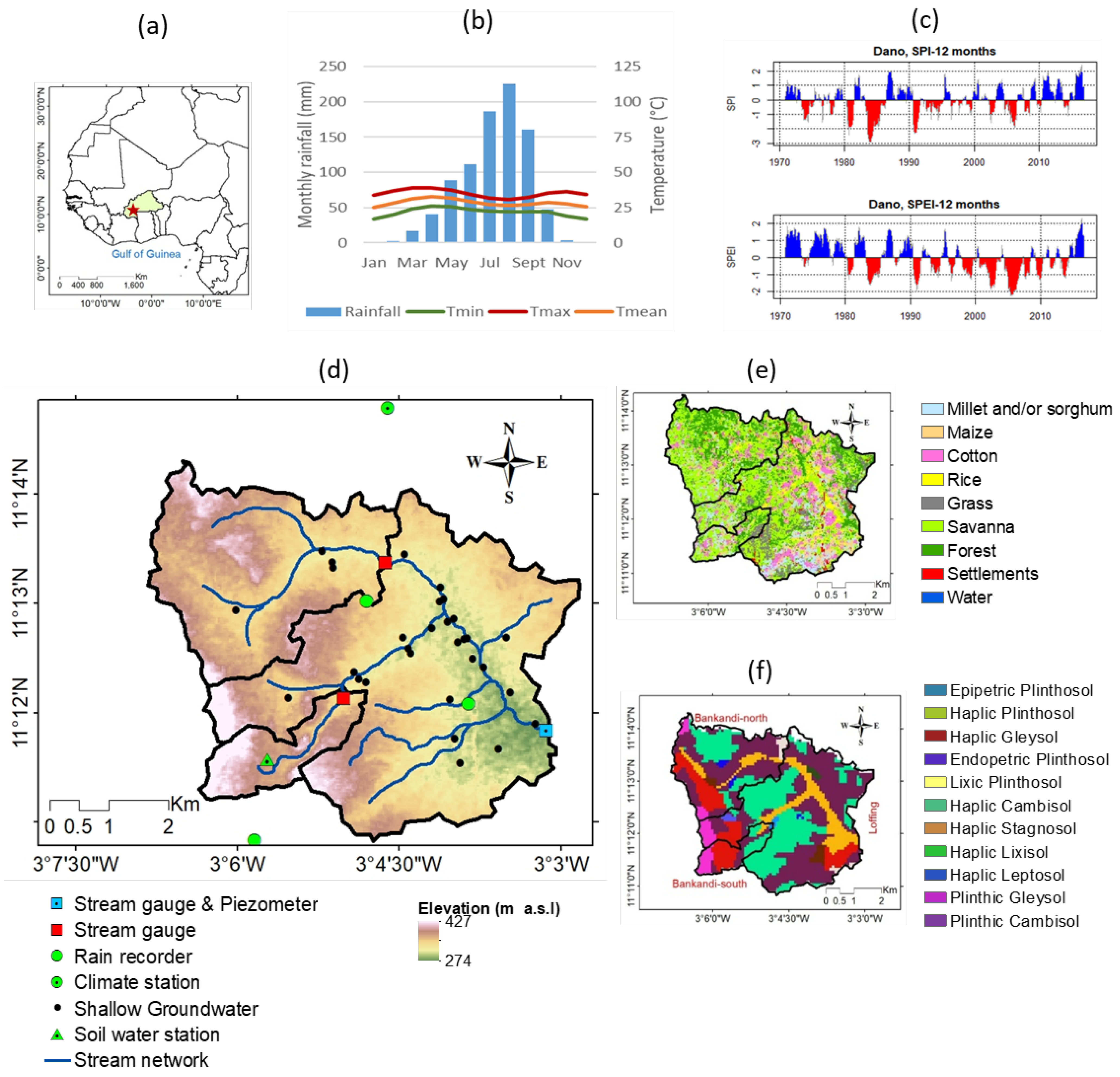
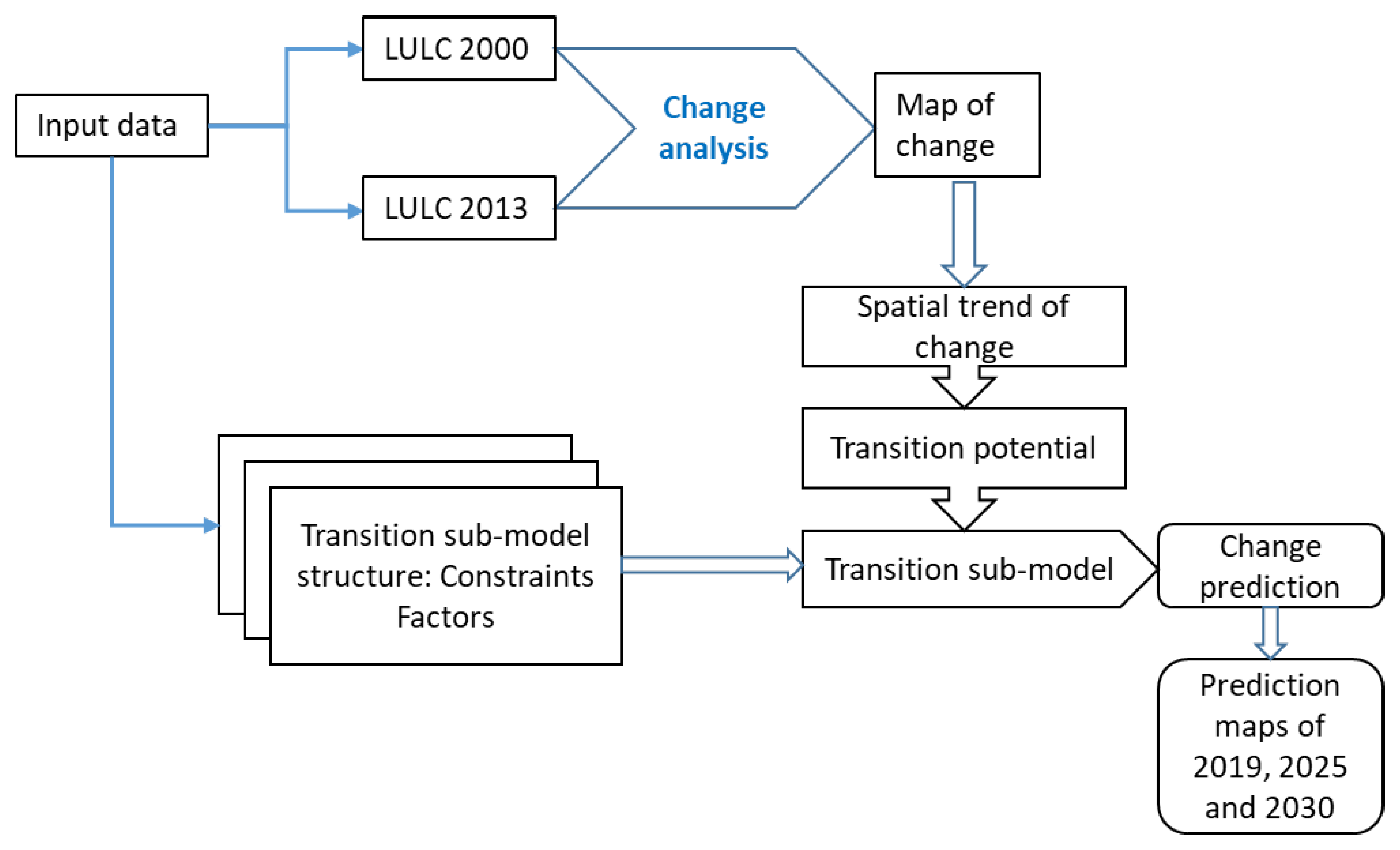
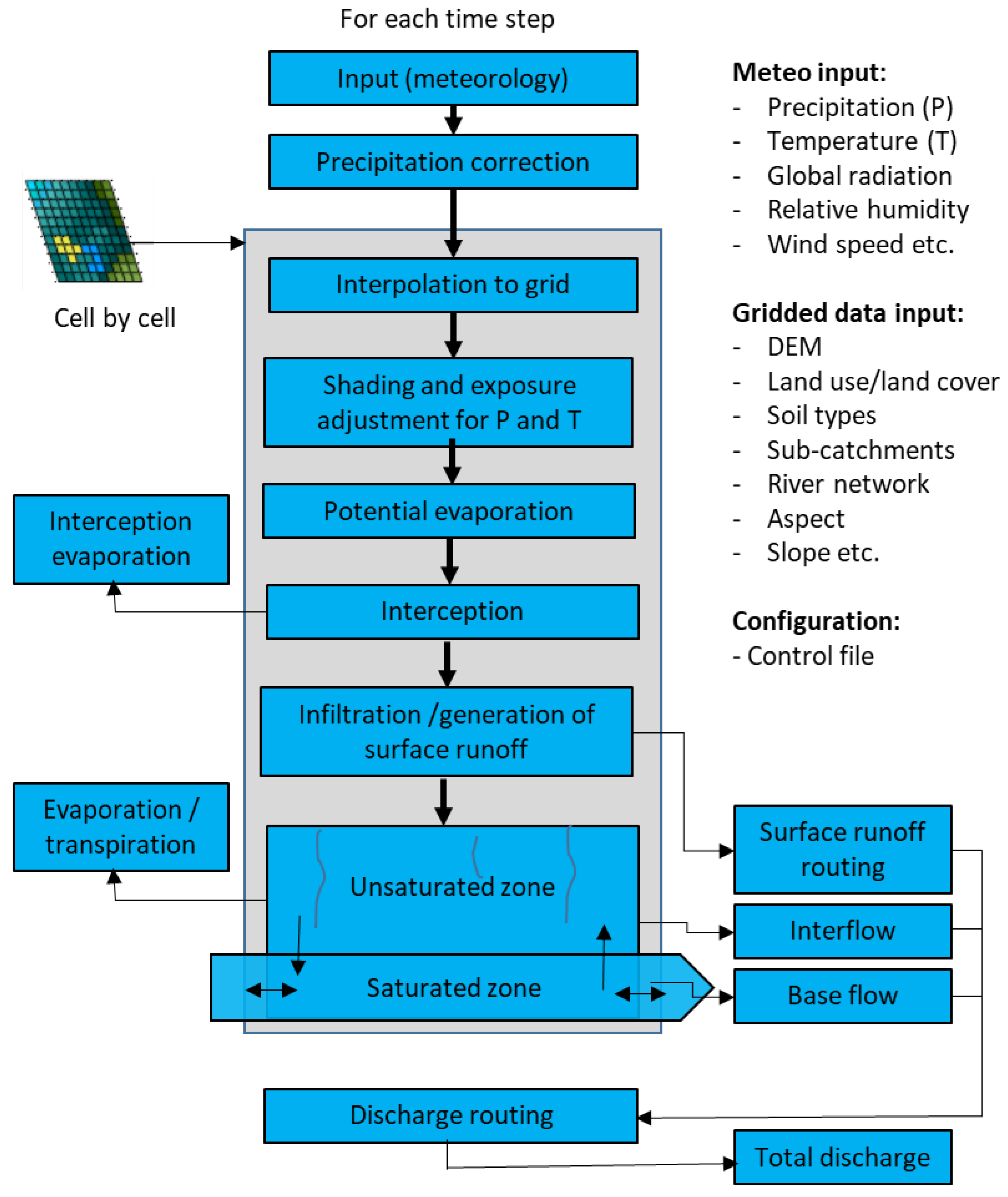
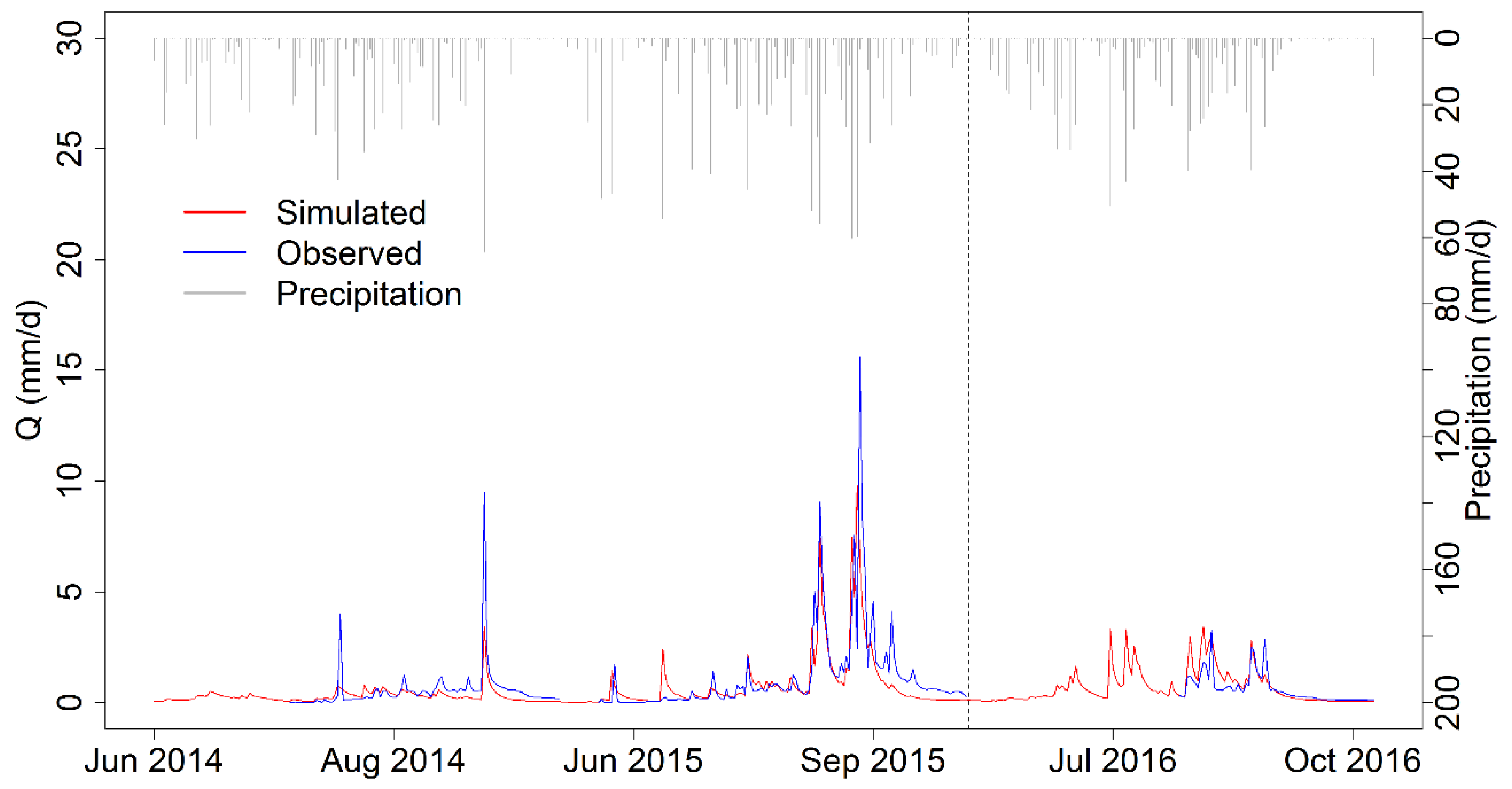

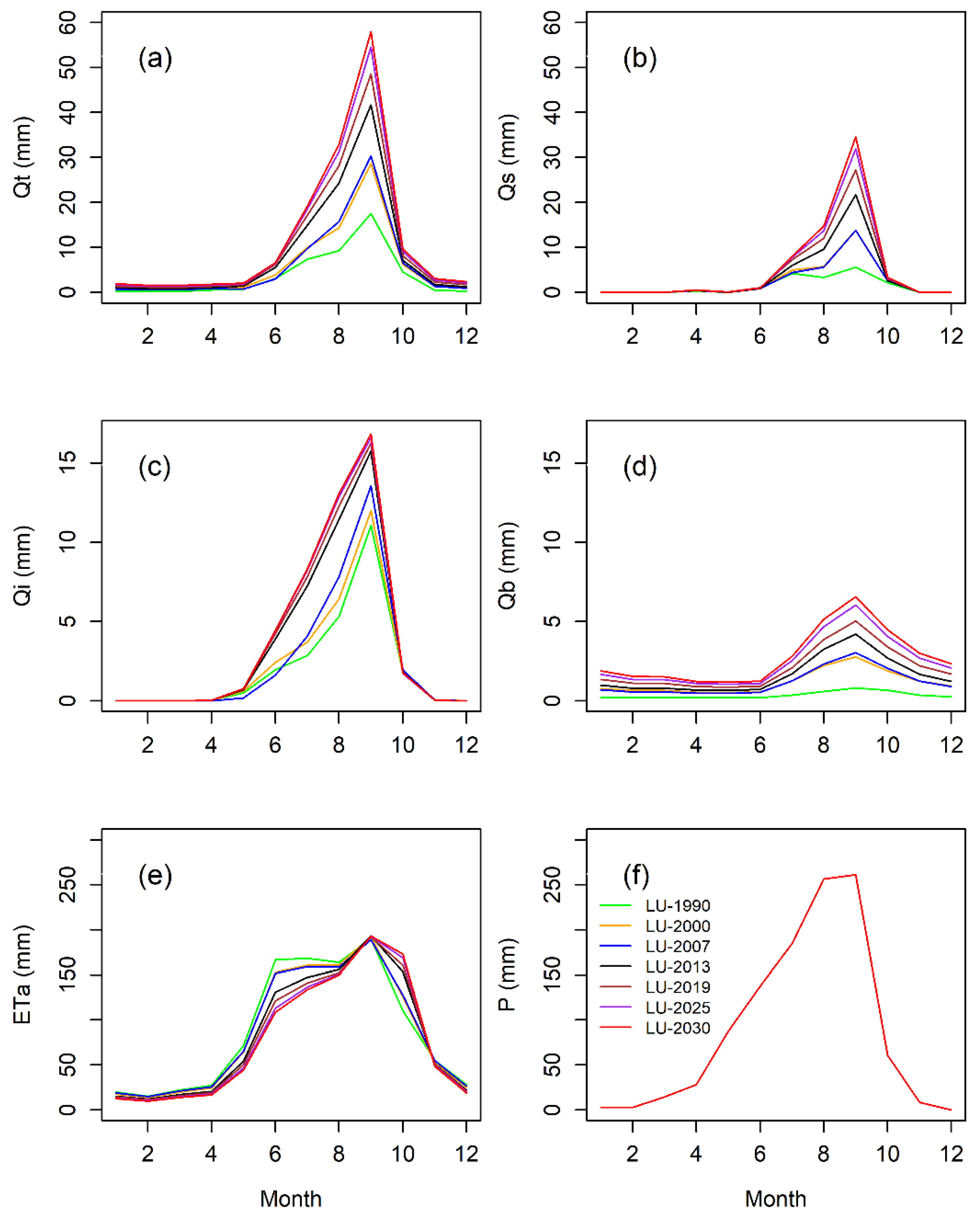

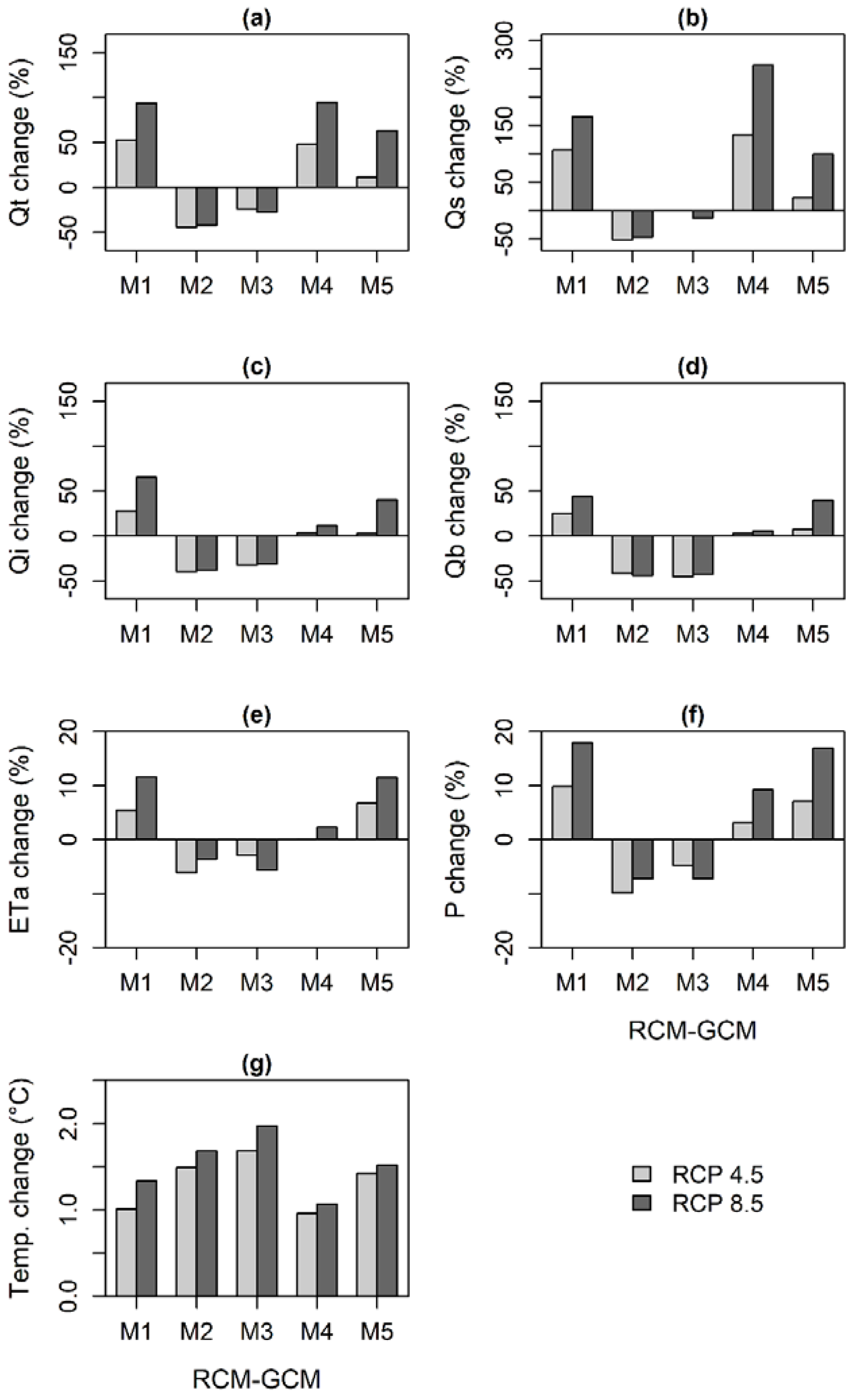
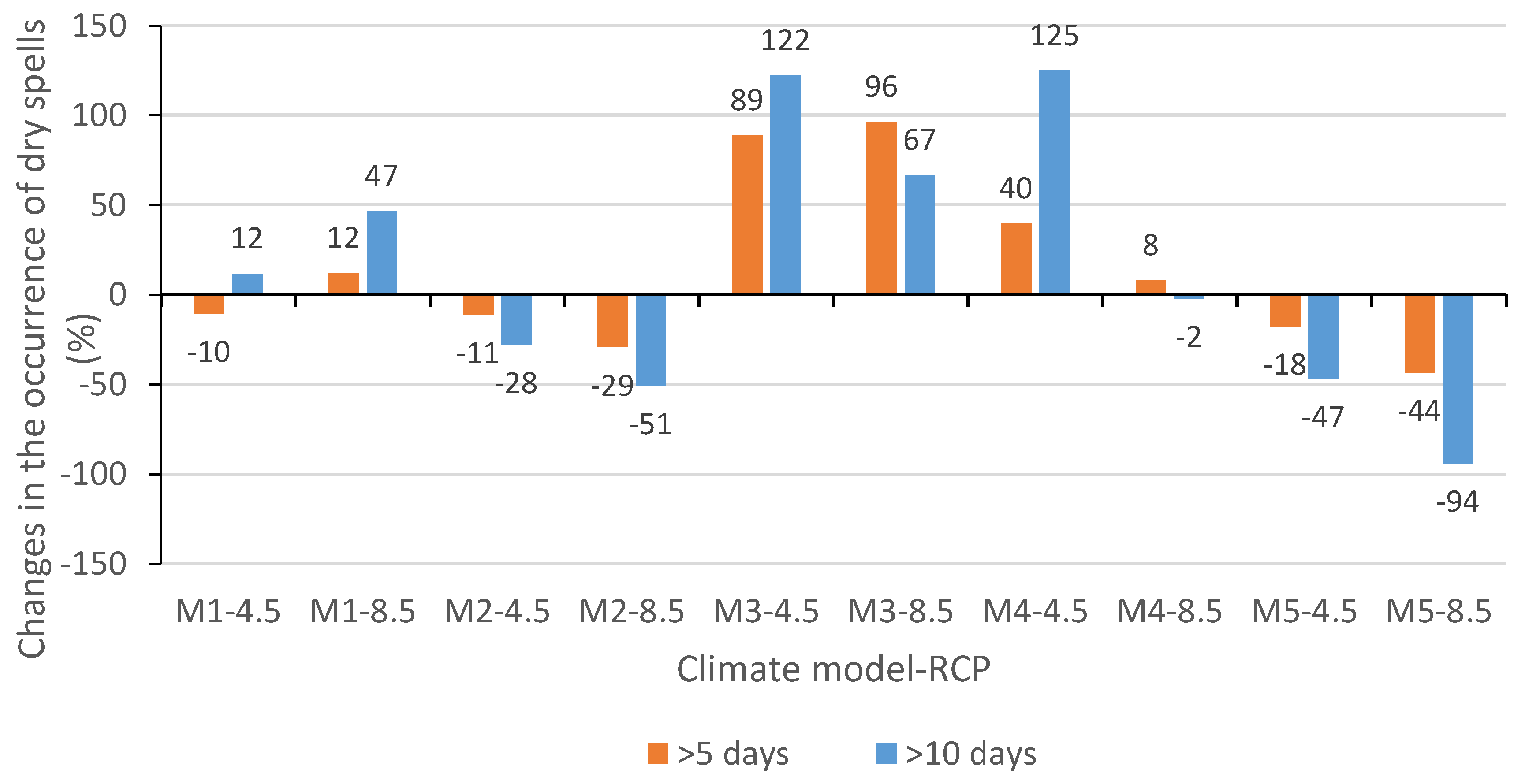

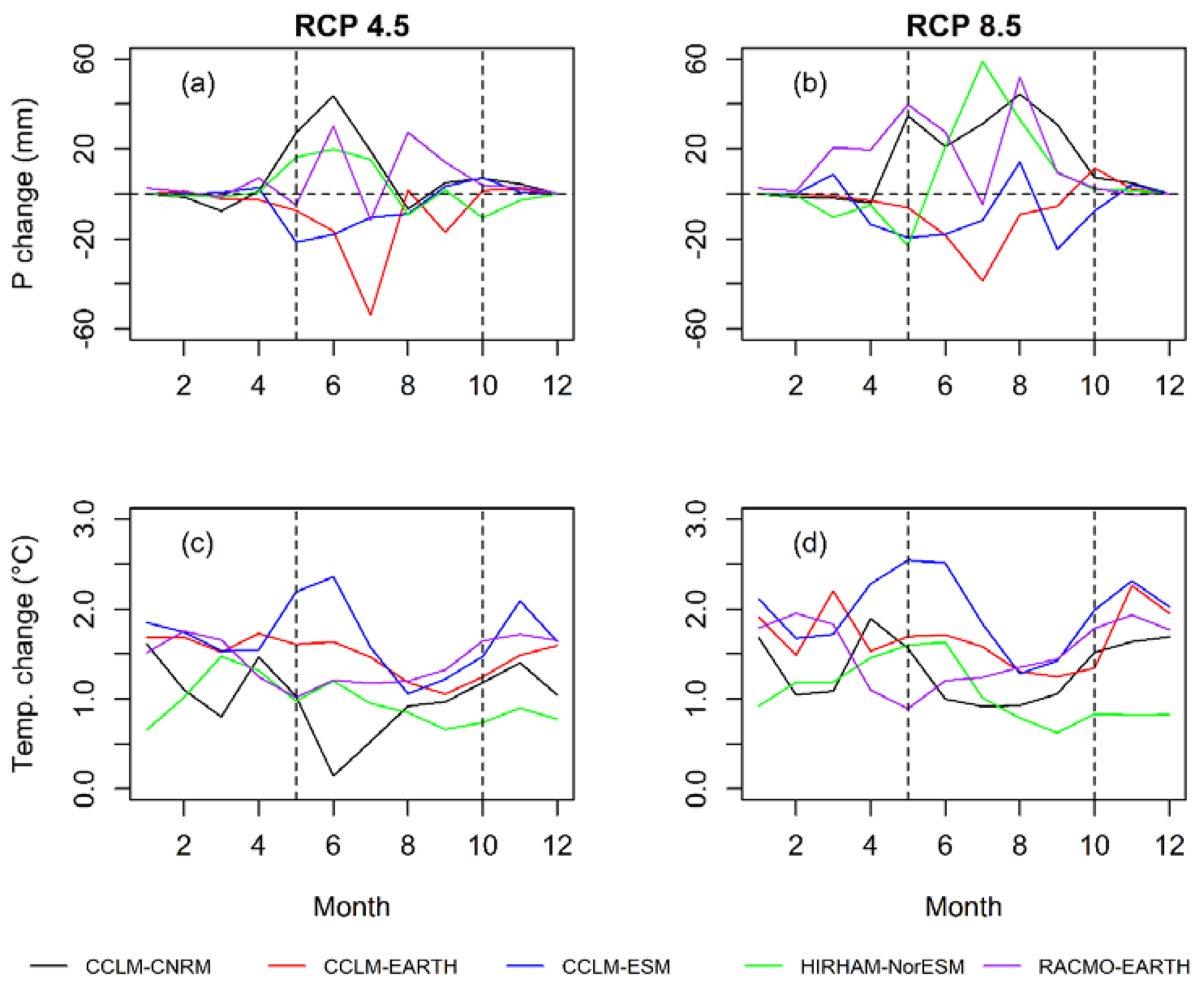

| RCM–GCM Label | RCM | Driving GCM | RCM Center/Institute | Country of RCM Center/Institute | Acronym (Yira et al. [17]) |
|---|---|---|---|---|---|
| M1 | CCLM48 | CNRM-CM5 | CCLMcom | Germany | CCLM-CNRM |
| M2 | CCLM48 | EC-EARTH | CCLMcom | Germany | CCLM-EARTH |
| M3 | CCLM48 | ESM-LR | CCLMcom | Germany | CCLM-ESM |
| M4 | HIRHAM5 | NorESM1-M | DMI | Denmark | HIRHAM-NorESM |
| M5 | RACMO22 | EC-EARTH | KNMI | Netherlands | RACMO-EARTH |
| Reference | Prediction | |||
|---|---|---|---|---|
| Scenario | LULC | Historical RCM–GCM | LULC | RCM–GCM (RCP 4.5 and 8.5) |
| 1 | 2013 | 1971–2000 | 2013 | 2021–2050 |
| 2 | 2013 | 1971–2000 | 2030 | 2021–2050 |
| Calibration (2014–2015) | Validation (2016) | Annual Mean (2014–2016) | |
|---|---|---|---|
| P (mm) | 1067 | 1001 | 1045 |
| ETa (mm) | 982 | 954 | 973 |
| Qt (mm) | 96 | 113 | 102 |
| Qs (mm) | 39 | 46 | 41 |
| Qi (mm) | 40 | 43 | 41 |
| Qb (mm) | 18 | 23 | 19 |
| Delta S (mm) | −11 | −66 | −30 |
| R² | 0.59 | 0.71 | - |
| NSE | 0.57 | 0.48 | - |
| KGE | 0.66 | 0.73 | - |
| Pbias (%) | −23.70 | 21.20 | - |
| Land Use and Land Cover | |||||||
|---|---|---|---|---|---|---|---|
| LU-1990 | LU-2000 | LU-2007 | LU-2013 | LU-2019 | LU-2025 | LU-2030 | |
| P (mm) | 1045 | 1045 | 1045 | 1045 | 1045 | 1045 | 1045 |
| ETa (mm) | 1039 | 1011 | 1014 | 973 | 950 | 934 | 924 |
| Qt (mm) | 44 | 69 | 71 | 102 | 119 | 133 | 140 |
| Qs (mm) | 16 | 28 | 27 | 41 | 51 | 58 | 62 |
| Qi (mm) | 24 | 27 | 29 | 41 | 43 | 45 | 45 |
| Qb (mm) | 4 | 14 | 14 | 19 | 25 | 30 | 33 |
Publisher’s Note: MDPI stays neutral with regard to jurisdictional claims in published maps and institutional affiliations. |
© 2022 by the authors. Licensee MDPI, Basel, Switzerland. This article is an open access article distributed under the terms and conditions of the Creative Commons Attribution (CC BY) license (https://creativecommons.org/licenses/by/4.0/).
Share and Cite
Idrissou, M.; Diekkrüger, B.; Tischbein, B.; Op de Hipt, F.; Näschen, K.; Poméon, T.; Yira, Y.; Ibrahim, B. Modeling the Impact of Climate and Land Use/Land Cover Change on Water Availability in an Inland Valley Catchment in Burkina Faso. Hydrology 2022, 9, 12. https://doi.org/10.3390/hydrology9010012
Idrissou M, Diekkrüger B, Tischbein B, Op de Hipt F, Näschen K, Poméon T, Yira Y, Ibrahim B. Modeling the Impact of Climate and Land Use/Land Cover Change on Water Availability in an Inland Valley Catchment in Burkina Faso. Hydrology. 2022; 9(1):12. https://doi.org/10.3390/hydrology9010012
Chicago/Turabian StyleIdrissou, Mouhamed, Bernd Diekkrüger, Bernhard Tischbein, Felix Op de Hipt, Kristian Näschen, Thomas Poméon, Yacouba Yira, and Boubacar Ibrahim. 2022. "Modeling the Impact of Climate and Land Use/Land Cover Change on Water Availability in an Inland Valley Catchment in Burkina Faso" Hydrology 9, no. 1: 12. https://doi.org/10.3390/hydrology9010012
APA StyleIdrissou, M., Diekkrüger, B., Tischbein, B., Op de Hipt, F., Näschen, K., Poméon, T., Yira, Y., & Ibrahim, B. (2022). Modeling the Impact of Climate and Land Use/Land Cover Change on Water Availability in an Inland Valley Catchment in Burkina Faso. Hydrology, 9(1), 12. https://doi.org/10.3390/hydrology9010012







